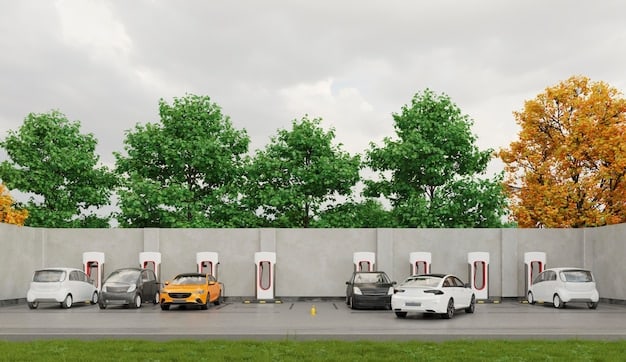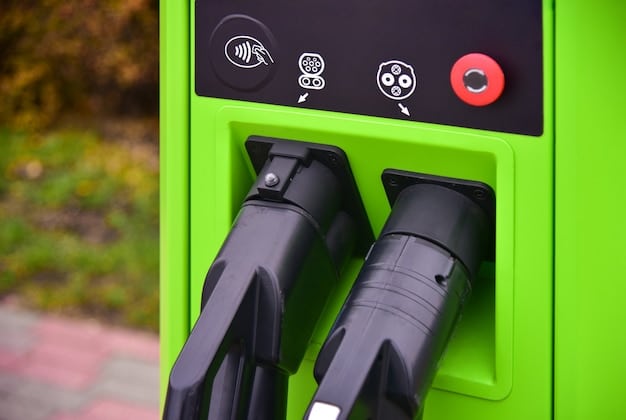US Electric Vehicle Adoption: Climate Change News & Infrastructure Progress

Climate change news focuses on the United States’ electric vehicle (EV) adoption, highlighting advances in EV technology, government initiatives promoting EV use, and infrastructure developments supporting the transition to electric mobility.
The latest climate change news: a look at the US’s progress on electric vehicle adoption and infrastructure reveals a nation at a crossroads, striving to balance ambitious climate goals with the practical realities of transitioning to sustainable transportation. The US is pushing towards an electrified future, but how far has it truly come?
The Current State of Electric Vehicle Adoption in the US
Electric vehicles (EVs) are rapidly gaining traction in the United States as a viable alternative to traditional gasoline-powered cars. But how widespread is this adoption really, and what factors are driving or hindering its further growth?
This section will examine the current market share of EVs, regional disparities in adoption rates, and the key incentives that encourage consumers to make the switch.
EV Market Share and Growth Trends
The electric vehicle market share in the US has been steadily increasing. While still a relatively small percentage of the overall automotive market, EV sales have seen significant year-over-year growth. This rising popularity is largely attributed to increasing awareness, improved technology, and growing concerns about climate change.
However, the pace of adoption varies considerably across different states and regions.
- California leads the way in EV adoption, driven by strong state-level incentives and a widespread charging infrastructure.
- States like Oregon, Washington, and Colorado also have relatively high adoption rates.
- The Southeast and Midwest regions generally lag behind due to factors like lower population density and less-aggressive policy support.

Government Incentives and Policies
Government incentives play a crucial role in encouraging EV adoption. Both federal and state governments offer a range of programs designed to make EVs more affordable and accessible.
These incentives include:
- Federal tax credits for EV purchases, providing significant savings for buyers.
- State-level rebates and tax incentives, further reducing the upfront cost of EVs.
- HOV lane access for EVs, allowing drivers to bypass traffic congestion in certain areas.
In conclusion, while EV adoption is growing in the US, it is not yet uniform across the country. Government incentives and regional factors continue to play a significant role in shaping the landscape of electric mobility.
Building the Infrastructure: Charging Stations and Network Development
A robust and reliable charging infrastructure is essential to support widespread EV adoption. Without easy access to charging stations, potential EV buyers may be hesitant to make the switch. How is the US doing at expanding its charging network?
This section will highlight the current state of the charging infrastructure, the challenges involved in expanding it, and the innovations that could shape the future of EV charging.
Current State of Charging Infrastructure
The US charging infrastructure is growing, but it still faces significant challenges. While the number of charging stations is increasing, it remains unevenly distributed across the country.
Key points about the current infrastructure:
- Most charging stations are concentrated in urban areas and along major transportation corridors.
- Rural areas often lack sufficient charging infrastructure, creating range anxiety for EV drivers.
- The availability of different charging levels (Level 2 and DC fast charging) varies significantly.
Expanding the charging infrastructure is a complex undertaking, with several challenges that need to be addressed.
Challenges in Expanding the Network
Several factors contribute to the difficulty of rapidly expanding the EV charging network. These include:
- High costs associated with installing and maintaining charging stations.
- Permitting and regulatory hurdles that can delay or complicate deployment.
- Grid capacity limitations in some areas, requiring costly upgrades to the electrical grid.

Innovations in Charging Technology
To overcome these challenges and accelerate the expansion of the charging network, several innovations are being explored. These include:
Wireless charging technology that allows EVs to charge without the need for cables.
Battery swapping stations where drivers can quickly exchange a depleted battery for a fully charged one.
Smart charging systems that optimize charging schedules to reduce strain on the grid.
In summary, building a comprehensive charging infrastructure is crucial to support the growth of the EV market. Addressing the challenges and embracing innovation will be key to achieving this goal.
Government Initiatives and Funding for Electric Vehicles
Government plays a pivotal role in accelerating the transition to electric vehicles by offering financial incentives, establishing regulatory frameworks, and investing in research and development. But what specific initiatives are in place, and how effective are they?
This section will explore key federal and state programs designed to promote EV adoption and the development of supporting infrastructure.
Federal Programs Supporting EVs
The federal government has introduced various programs aimed at boosting the adoption of electric vehicles. These initiatives primarily focus on:
Offering tax credits to consumers who purchase new or used EVs, significantly reducing the initial cost.
Providing grants and loans to companies involved in the manufacturing of EVs and batteries, supporting the growth of the domestic EV industry.
Allocating funds for research and development of advanced battery technologies and charging infrastructure.
State-Level EV Initiatives
Many states have also implemented their own programs to encourage EV adoption. These initiatives often complement federal programs and may include:
Providing additional rebates and tax incentives for EV purchases, further reducing the cost for consumers.
Establishing charging infrastructure deployment targets and providing grants to support the installation of charging stations.
Implementing policies that prioritize EVs in transportation planning and promote the electrification of public transportation fleets.
Effectiveness and Impact of Government Initiatives
The effectiveness of these government initiatives is a subject of debate. While they have undoubtedly contributed to the growth of the EV market, several factors limit their impact:
Limited funding and eligibility requirements may restrict the number of people who can benefit from tax credits and rebates.
Regulatory hurdles and permitting delays can slow down the deployment of charging infrastructure.
Lack of awareness and consumer education may hinder the effectiveness of outreach programs.
In conclusion, government initiatives are essential in driving EV adoption, but their impact could be further enhanced by addressing existing limitations and implementing more targeted and effective programs.
Consumer Perceptions and Barriers to EV Adoption
Consumer perceptions and attitudes play a crucial role in determining the pace of EV adoption. What are the main concerns and misconceptions that prevent potential buyers from making the switch to electric vehicles?
This section will examine key barriers to EV adoption from the consumer perspective and explore strategies for overcoming these obstacles.
Key Barriers to EV Adoption
Several factors contribute to the hesitation among consumers to adopt electric vehicles. These include:
- Range anxiety: The fear that an EV will run out of battery before reaching a charging station.
- High upfront cost: EVs generally have a higher purchase price compared to gasoline-powered cars.
- Charging time: The time it takes to recharge an EV can be significantly longer than filling a gasoline tank.
- Limited charging infrastructure: The availability of charging stations is still limited in many areas.
Addressing Consumer Concerns
To overcome these barriers and encourage EV adoption, it is essential to address consumer concerns through:
- Improving battery technology to increase driving range and reduce charging time.
- Lowering the upfront cost of EVs through government incentives and manufacturer initiatives.
- Investing in the expansion of charging infrastructure to provide convenient and reliable charging options.
- Educating consumers about the benefits of EVs, including lower operating costs and environmental advantages.
Changing Consumer Perceptions
Changing consumer perceptions about EVs requires a multi-faceted approach that involves:
- Demonstrating the real-world performance and reliability of EVs through test drives and pilot programs.
- Highlighting the positive experiences of EV owners through testimonials and social media campaigns.
- Promoting the environmental benefits of EVs and their contribution to reducing greenhouse gas emissions.
In summary, overcoming consumer barriers to EV adoption requires a combination of technological advancements, government policies, and effective communication strategies.
The Role of Automakers in the Electric Vehicle Transition
Automakers are at the forefront of the electric vehicle transition, investing heavily in research and development, manufacturing, and marketing of EVs. How are these companies adapting to the changing landscape, and what strategies are they employing to promote EV adoption?
This section will explore the role of major automakers in the EV revolution and examine their efforts to develop and market electric vehicles.
Automaker Investments in EVs
Major automakers are making significant investments in the development and production of electric vehicles. These investments include:
- Billions of dollars allocated to research and development of new EV technologies, including battery technology, electric motors, and charging systems.
- Construction of new manufacturing facilities dedicated to producing EVs and batteries.
- Partnerships with battery manufacturers and technology companies to secure access to critical components and expertise.
EV Model Offerings and Market Strategies
Automakers are expanding their EV model offerings to cater to a wider range of consumer preferences and needs. These offerings include:
- Compact EVs for urban commuters.
- SUVs and crossovers with extended range and cargo capacity.
- Electric pickup trucks for commercial and recreational use.
Challenges and Opportunities for Automakers
The transition to electric vehicles presents both challenges and opportunities for automakers. Some of the key challenges include:
- Managing the high costs associated with developing and manufacturing EVs.
- Securing a reliable supply of critical battery materials, such as lithium and cobalt.
- Adapting their manufacturing processes and supply chains to accommodate EV production.
In conclusion, automakers play a crucial role in driving the electric vehicle transition. By investing in EV technology, expanding their model offerings, and embracing innovative market strategies, they can accelerate the adoption of EVs and contribute to a cleaner, more sustainable transportation system.
Future Outlook: The Trajectory of Electric Vehicle Adoption in the US
Looking ahead, what is the likely trajectory of electric vehicle adoption in the US, and what factors will shape its future? What can we expect in the coming years and decades?
This section will provide a future outlook for EV adoption, considering technological advancements, policy changes, and market trends.
Projected Growth of the EV Market
The electric vehicle market in the US is projected to continue its rapid growth in the coming years, driven by:
Continued improvements in battery technology, leading to increased driving range and reduced charging time.
More stringent government regulations on greenhouse gas emissions, incentivizing the adoption of zero-emission vehicles.
Growing consumer awareness and acceptance of EVs, driven by positive experiences and environmental concerns.
Key Trends Shaping the Future of EVs
Several key trends are expected to shape the future of electric vehicles in the US. These include:
The development of autonomous driving technologies that will enhance the safety and convenience of EVs.
The integration of EVs with smart grid technologies, enabling EVs to serve as mobile energy storage devices.
The proliferation of shared mobility services that utilize EVs, making electric transportation more accessible to a broader range of people.
Challenges and Uncertainties
Despite the positive outlook, several challenges and uncertainties remain. These include:
The pace of expansion of the charging infrastructure, which must keep up with the growing number of EVs on the road.
The availability and affordability of critical battery materials, which could impact the cost and production of EVs.
The potential for disruptions in the global supply chain, which could affect the availability of EVs and components.
In conclusion, the future of electric vehicles in the US appears bright, with continued growth and innovation expected in the coming years. Addressing the remaining challenges and uncertainties will be essential to realizing the full potential of electric mobility.
| Key Point | Brief Description |
|---|---|
| ⚡ EV Adoption Growth | Increasing, but varies by region; influenced by incentives and infrastructure. |
| 📍 Charging Infrastructure | Expanding, but unevenly distributed; faces cost and regulatory challenges. |
| 💰 Government Support | Federal and state incentives boost adoption, but impact limited by funding. |
| 🚗 Automaker Role | Investing heavily in EV development, expanding model offerings. |
Frequently Asked Questions
▼
The main incentives include federal tax credits, state-level rebates, and access to HOV lanes. These incentives help reduce the upfront cost and provide additional benefits for EV owners.
▼
The charging infrastructure is growing but is still unevenly distributed. Most charging stations are located in urban areas and along major transportation corridors, while rural areas often lack sufficient charging options.
▼
The biggest challenges include range anxiety, high upfront cost, long charging times, and limited charging infrastructure. Addressing these concerns is crucial to accelerating EV adoption.
▼
Automakers are investing heavily in EV research and development, expanding their EV model offerings, and partnering with battery manufacturers to secure access to critical components and expertise.
▼
The EV market in the US is projected to continue its rapid growth, driven by technological advancements, government regulations, and growing consumer awareness, with challenges remaining in infrastructure and material availability.
Conclusion
The US is making strides in electric vehicle adoption and infrastructure development, but challenges remain. Government incentives, automaker innovation, and addressing consumer concerns are crucial for a sustainable transition to electric mobility, paving the way for a cleaner and more efficient transportation future.





